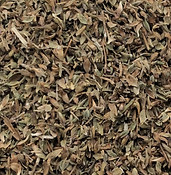


Welcome to the home of Greek organic herbs
Thyme (Thymus vulgaris)
Thyme (Thymus capitatus)
The thyme is a medicinal and spice plant. The highly fragrant thyme herb has been used as a spice and medicinal plant for over 4000 years.
The name is derived from the Greek word thymos , which can be translated as "courage" or "strength".
Thyme is the medicinal plant of 2006.
ingredients
Essential oils (borneol; pinene; cymene; camphor; carvacrol; limonene; linalool; thymol)
Flavonoids, tannins
Coumarin, salicylates
Saponins
The difference between thyme (Thymus vulgaris) and
Thyme (thymus capitatus)
Thymus vulgaris
The main components of its essential oil are thymol, carvacrol, linalool, geraniol, α-terpineol. However, there is a notable variation in the percentage of the above components, indicating the existence of different thyme chemotypes. Typical aroma of thyme due to the percentage of thymol. The color is usually more green compared to capitatus ssp.
Thymus capitatus
In the past, the species of the genus Thymus also included T. Capitatus, the head thyme, which is known as thyme in many parts of Greece. Today, however, its widely accepted Latin name is Coridothymus capitatus and it is marketed as "oregano" because of a common trait they share, their similar odor, which is due to the presence of carvacrol in their essential oils.
In general, the organoleptic properties are more similar to oregano.
enlarge the detailed images with one click

thyme (capitatus)
15-910

thyme (capitatus)
75-930

real thyme (vulgaris)
45-650
